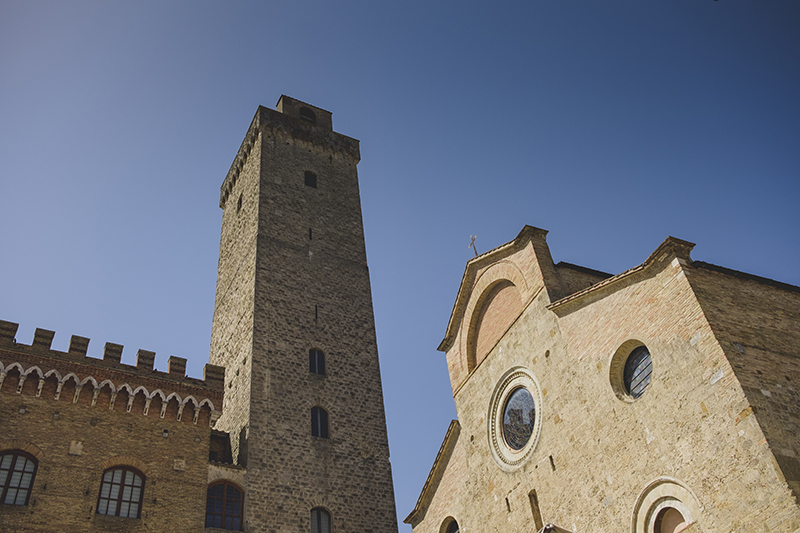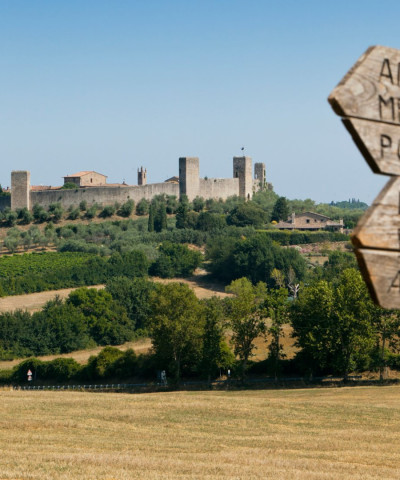Towers and cypress trees
A journey through Volterra and San Gimignano following the advice of three very locals
Directors and poets throughout history have been bewitched by Volterra’s Etruscan mystique and San Gimignano’s wonderful charm, so captivated by its landscapes they took inspiration from them in their work.
Literature is peppered with illustrious quotes about these two jewels tucked between the Cecina and Elsa valleys, providing glimpses of unparalleled Tuscan beauty, the towers and cypresses, the Middle Ages and the Etruscans. From the ancient walls of Volterra to the farmhouses surrounded by centuries-old olive trees and lines of cypress trees marking the contours of the gently rolling hills, in shades of green to the amber glow of clay from the iconic clay cliffs, known as the Balze di Volterra. It was these large chasms, visible to the naked eye, that swallowed up the city’s Etruscan necropolises and buried Etruscan civilisation, although its mystique lives on.
Oliviero Toscani, a superstar photographer and wine producer with an estate between Volterra and Bolghieri, paints the Etruscan city as “wind and folly”, like the name of his latest series of photography workshops held in the town itself. The artist (formerly councillor for culture in the Sicilian town of Salemi) holds on to his dream of becoming Volterra’s mayor: “It would be so much fun, and with a bit more initiative, we could do so much in this town.” For him, Volterra is steeped in a special kind of magic, in Etruscan times it was the capital of Europe. But best not ask the world-class photographer which special place best reveals the town’s Etruscan soul: “Impossible, you see what you feel,” he says.
Oliviero Toscani is particularly fond of Volterra in winter when it is battered by the wind, and he believes that “the special magic of the place lies in the tangle of streets which wind up and down the town.” The town is jolt to the heart and peace for the mind, and reminds Toscani of The Deposition by Rosso Fiorentino, which is conserved in the local Art Gallery, a place Oliviero visits often. Volterra is also the perfect place to hang out the orange blossom. Toscani should know. He and his wife married forty years ago in the San Giusto church, which rose from the ashes of a predecessor when it was devoured by the crumbling cliffs in the 17th century.
Volterra is a forty-minute car journey from San Gimignano. The road towards the town hugs gentle bends, weaving its way through the verdant Tuscan countryside, as if on a quest to find new magic.
It leaves us by the feet of the San Gimignano city walls but the real magic is further up where the UNESCO heritage site enchants with its 13th century walls which enclose the two main streets and high towers, giving it an almost salon feel. San Gimignano is the home of Vernaccia, the noble wine that was much loved by many a literary coterie, such as Dante and Cecco Angiolieri, Dante and Bocaccio, not forgetting English author, Geoffrey Chaucer.
Letizia Cesani, president of the San Gimignano wine-makers consortium, adores the Pieve romanica di Cellole church, which stands on a hilltop with sweeping views of the towers dominating the skyline. “It is a mystical place that is scarcely visited but the perfect vantage point from which to admire the breath-taking countryside.
Few tourists take advantage of it but it is outstandingly beautiful.” Drawing on her vast knowledge of the field, she recommends the Vernaccia di San Gimignano Wine Experience which is more than a mere wine museum: it is the ideal place to enjoy a sensory experience of the highest of levels. Every day, knowledgeable, polyglot sommeliers lead theme-based seminars on the pairing of food and wine using locally-sourced PDO and PGI products.
For shopping opportunities, Letizia Cesani suggests heading to the artisan workshops of ceramic artists Fabio Balducci and Silvia Beghè, calling them “treasure troves of unparalleled works of art.” In such a gem of mediaeval architecture, the last thing you might expect is a contemporary scion.











